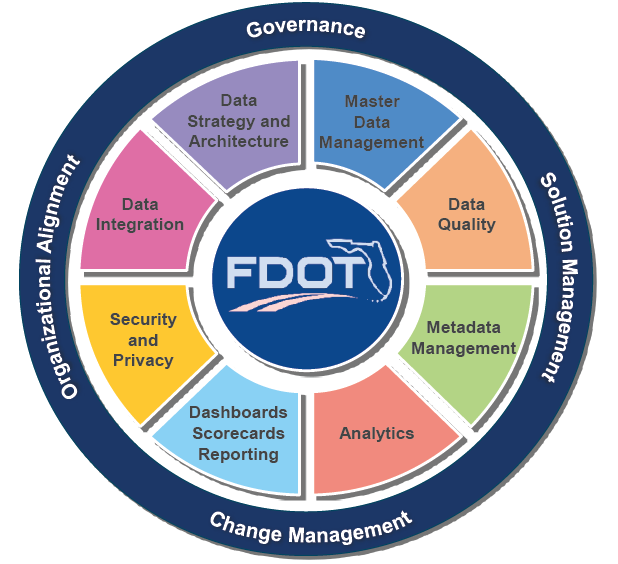- Chapters
-
Chapter 7
Sections - Chapter 7 Home Page
- Chapter PDF
Chapter 7
Quick Links
7.4.1
Fundamental Concepts and Principles
Data governance and management practices are essential for achieving reliable, consistent, integrated and accessible data that is of value for decision-making. Several definitions, concepts and principles are important to understand before embarking on a data governance initiative.
Data Management and the TAM Data Assistant
Data governance and data management are interrelated but distinct practices.
Data management includes activities such as data quality management, data documentation, metadata management, security and access controls, data integration, and data archiving.
Data governance is a policy making and oversight function for data management. Implementing data governance involves forming and chartering decision making bodies, defining roles and responsibilities, establishing policies that set expectations for behavior, and setting up standard processes for things like approving data standards, resolving data issues, and acquiring new types of data. Data governance is generally implemented in a hierarchical fashion, with an executive body at the top, a data council or board in the middle, and several more focused groups oriented around specific systems, business processes, organizational units or functions.
Data stewardship is closely related to data management and governance. It refers to established responsibilities and accountabilities for managing data. In general parlance, a steward is someone who is entrusted with the responsibility for taking care of someone else’s property. Similarly, a data steward is someone who takes care of data on behalf of their agency. Different types of stewardship roles can be defined and formalized within an agency data governance policy. Data stewardship can be viewed as the way to operationalize data governance policies, processes and standards.
Data governance can be implemented to:
- Improve quality and consistency of data
- Ensure coordination across different business units
- Maximize efficiency in data collection and management processes
- Enable data integration and shared solutions to make the most of available IT resources
- Ensure there is a solid business case for new data collection
- Ensure that data will be maintained once it is collected
Agencies may be motivated to establish a formal data governance function as they try to move from a siloed approach to collecting and managing data to one that is more coordinated and centralized.
For example, implementing a reporting system that takes data from multiple sources within the agency creates the need for standardization, documentation, and agreed-upon update cycles. It is important to get agreement on standard data definitions, formats and code lists from different business units to achieve consistency. It is also important to clarify who is responsible for fixing errors and the process for error correction in the event that errors occur.
Data governance is a means to an end. It is important to clearly define and communicate why an agency needs to strengthen data governance: what is happening now that the agency may want to avoid (such as data duplication)? What is not happening now that the agency may want to achieve (such as standardized data)? The effort involved in putting data governance in place should not be underestimated, since it involves changes in how decisions are made and changes in behavior. A full scale agency data governance model can take years to mature. However, data governance can be rolled out incrementally to focus on short term objectives. It is a good idea to adopt a set of principles to provide the foundation for data governance policies and practices. The AASHTO Data Principles (see callout box) can be used as a model.
TIP
Data itself should be viewed as an asset to be managed.
Florida DOT
Florida Department of Transportation (FDOT) launched a statewide initiative to better manage and integrate agency data. This effort combines the resources, goals, and objectives of Florida’s Technology and Operation Divisions into the initiative known as ROADS, which stands for:
- R—Reliable, accurate, authoritative, accessible data
- O—Organized data that produces actionable information
- A—Accurate governance-produced data
- D—Data and technology integration
- S—Shared agency data to perform cross-functional analysis
The agency has created processes, procedures, and guidelines so that all data (financial, safety, project, program, assets, etc.) are organized and accessible. Florida’s steering committee, known as RET (ROADS Executive Team), is led by the agency’s Chief of Transportation Technology and Civil Integrated Management Officer. The committee, which includes district secretaries, financial and planning executives, and operational directors, is charged with governance leadership and instituting processes that will change the culture of the agency by converting data to knowledge.
ROADS is being implemented incrementally, through a series of 6-month initiatives. One initiative related to asset management is to standardize inventory attributes for 120 different classes of infrastructure assets and the agency’s approximately 170 enterprise software applications. Part of this effort is to determine specific authoritative source data to include in a new data warehouse. The data warehouse will provide a single authoritative site for sharing the accurate data.
Through the ROADS initiatives, Florida DOT has created a strategic direction for data integration covering data stewards, division responsibilities, asset inventory, business system integration, and an implementation roadmap. By coordinating its efforts, the agency is able to maximize the value of its data while streamlining processes for data collection, management, and dissemination.
Florida DOT Enterprise Information Management
Source: Florida DOT. 2019

